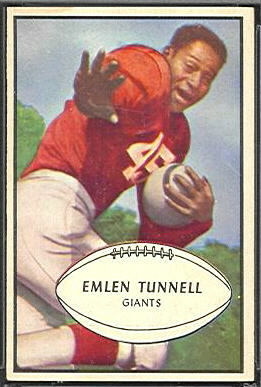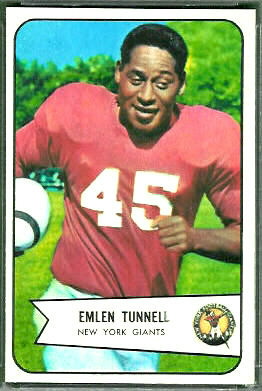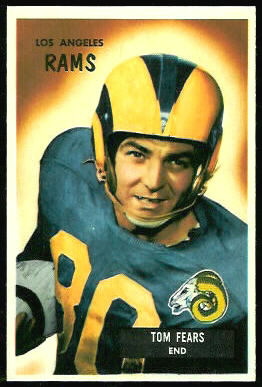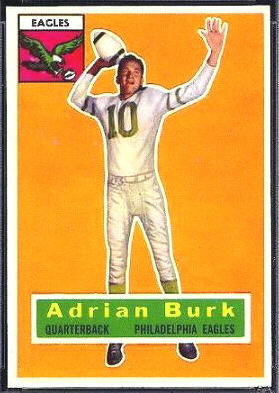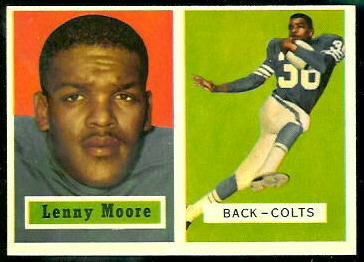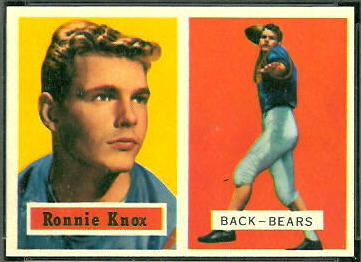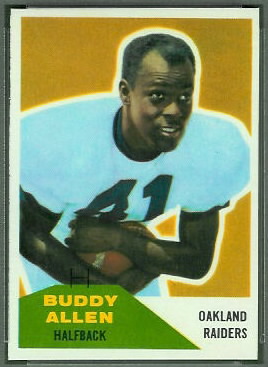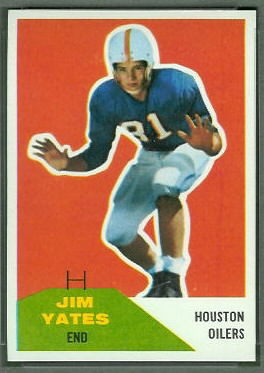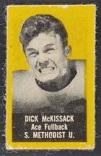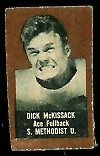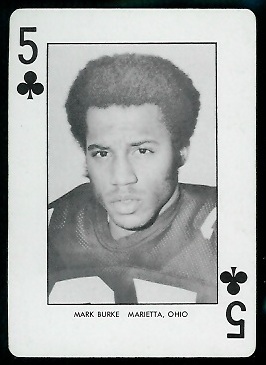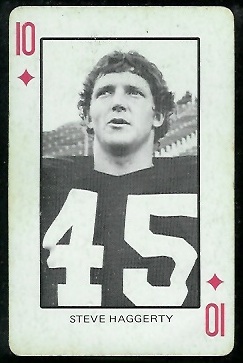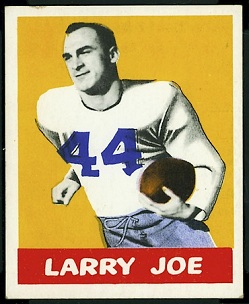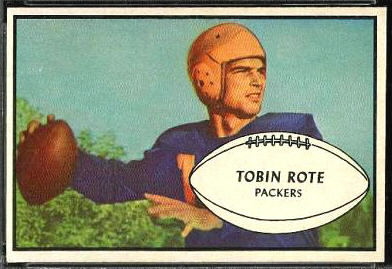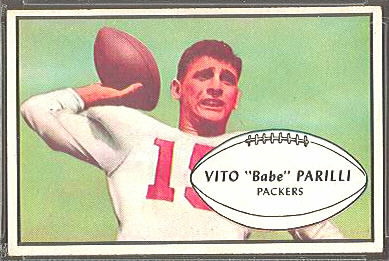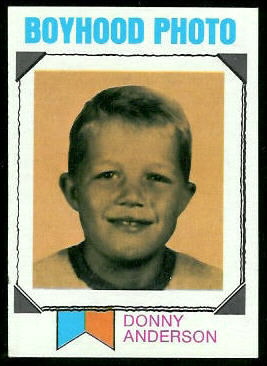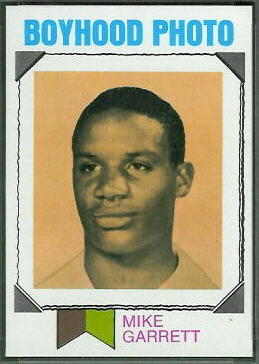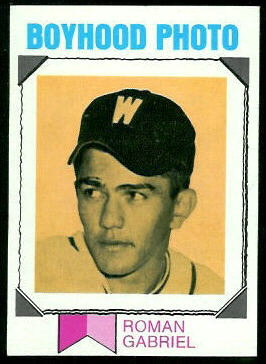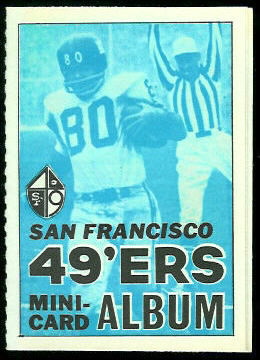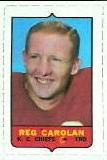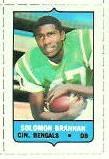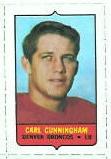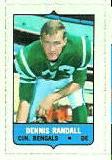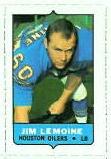New in the Gallery: 1964 Wheaties Stamps
October 2nd, 2009 | Published in Football Card Oddities, New in the Gallery
Today I added 1964 Wheaties Stamps to the Vintage Football Card Gallery. When I bought my first group of these stamps, I assumed that they would be the thickness of a card, like the 1969 Topps 4-in-1 inserts. I found, though, that they’re like postage stamps, only much bigger: 2 3/4 by 2 1/2 inches. Because they’re so big and on such thin paper, they are fragile, and bending one can leave an indentation, even if it doesn’t leave a crease.
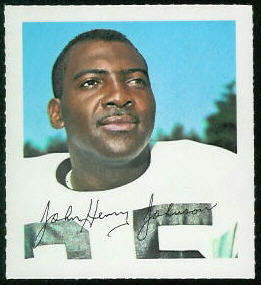
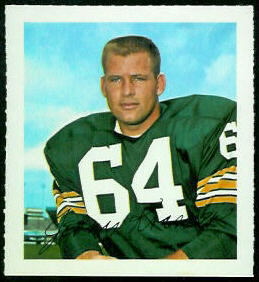 There are 74 stamps in the set: 70 player photos and 4 team emblems. The player photos are sharp and bright. Most of the photos are waist-up or head-and-shoulders shots, and Y.A. Tittle is the only player whose face is obscured by his helmet. (Tittle must have preferred posing in his helmet. Most of his cards picture him wearing it.) My two favorite stamps, Jerry Kramer and John Henry Johnson, are shown here.
There are 74 stamps in the set: 70 player photos and 4 team emblems. The player photos are sharp and bright. Most of the photos are waist-up or head-and-shoulders shots, and Y.A. Tittle is the only player whose face is obscured by his helmet. (Tittle must have preferred posing in his helmet. Most of his cards picture him wearing it.) My two favorite stamps, Jerry Kramer and John Henry Johnson, are shown here.
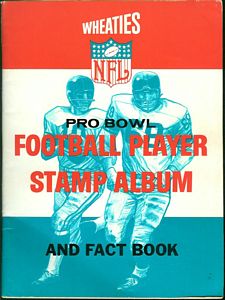 The stamps go with a magazine-sized booklet called the Wheaties NFL Pro Bowl Football Player Stamp Album and Fact Book–or WNPBFPSAFB for short. You could buy the album for 50 cents via a mail-in offer from General Mills. The stamps were originally part of the album, most of them on pages just inside the back and front covers. There were 6 pages of stamps, with 12 stamps on each page. That makes 72 stamps, and there were 2 more on a small panel adhered to the inside of the front cover. In my album, the tab from the small panel is still there, and there are remnants of the stamp pages along the album’s spine.
The stamps go with a magazine-sized booklet called the Wheaties NFL Pro Bowl Football Player Stamp Album and Fact Book–or WNPBFPSAFB for short. You could buy the album for 50 cents via a mail-in offer from General Mills. The stamps were originally part of the album, most of them on pages just inside the back and front covers. There were 6 pages of stamps, with 12 stamps on each page. That makes 72 stamps, and there were 2 more on a small panel adhered to the inside of the front cover. In my album, the tab from the small panel is still there, and there are remnants of the stamp pages along the album’s spine.
The 6 full pages were printed on a single master sheet, as you can see on the Topps Vault web site. (Evidently Topps supplied the stamps and album for General Mills.) The master sheet is missing two stamps, Norm Snead and Jack Pardee, the two that came on the small panel stuck to the inside of the album’s front cover. This small panel seems odd, when Topps could have fit Snead and Pardee on the master sheet by displacing two of the team emblem stamps. Perhaps it was just poor planning: “Oh, crap, we forgot Snead and Pardee. Quick, make a little two-stamp panel!”
The non-stamp pages of the album include a short writeup for each player, and a place to stick his stamp. The players are grouped by conference, first the Eastern Conference players, then the Western Conference players. (The Pro Bowl back then matched the East against the West.) Within each conference, the players appear in alphabetical order–almost. I wonder how many kids noticed that Mitchell came before Michaels, and Promuto came before Pottios? 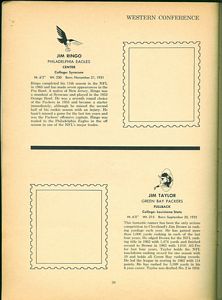 Also, the album shows Jim Ringo in transition from the Packers to the Eagles: his writeup says Eagles, but he’s still on the Western Conference side of the album. (According to Packers legend, after the 1963 season, Ringo appeared with his agent in Vince Lombardi’s office, asking for a raise. Lombardi left the room, returned in five minutes, and told Ringo he’d been traded to the Eagles.)
Also, the album shows Jim Ringo in transition from the Packers to the Eagles: his writeup says Eagles, but he’s still on the Western Conference side of the album. (According to Packers legend, after the 1963 season, Ringo appeared with his agent in Vince Lombardi’s office, asking for a raise. Lombardi left the room, returned in five minutes, and told Ringo he’d been traded to the Eagles.)
All of the players on the stamps played in the 1963 Pro Bowl. According to pro-football-reference.com, there were 71 players in the Pro Bowl that year, so one Pro Bowler didn’t get a stamp. Who went stampless? It was Frank Gifford, but I don’t know why he was excluded.
Oddly, though there are 70 player stamps, the album has writeups for only 68 of the players. Joe Schmidt and Y.A. Tittle appear on stamps, but they were omitted from the album. It’s not like there wasn’t room: the creators of the album included several pages of Pro Bowl history, facts, and records, and they could easily have squeezed in another couple of players. Unless I am missing a page, though, there is no place for Schmidt and Tittle.
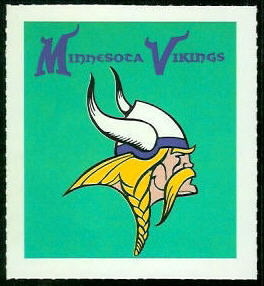 It’s also odd that there are only four team emblem stamps. The Vikings, 49ers, Cardinals, and Giants are the only teams with stamps, a pity because the team emblems are colorful and fun. There is no place in the album to stick the four team stamps, either.
It’s also odd that there are only four team emblem stamps. The Vikings, 49ers, Cardinals, and Giants are the only teams with stamps, a pity because the team emblems are colorful and fun. There is no place in the album to stick the four team stamps, either.
- See all of the 1964 Wheaties Stamps in the Vintage Football Card Gallery
- Find 1964 Wheaties Stamps on eBay
